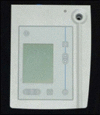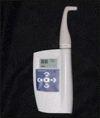A comparative study on the accuracy of the devices for measuring the implant stability
- PMID: 21165267
- PMCID: PMC2994689
- DOI: 10.4047/jap.2009.1.3.124
A comparative study on the accuracy of the devices for measuring the implant stability
Abstract
Statement of problem: How the ISQ values measured by Osstell™ and Osstell™ Mentor are related, and whether the ISQ values acquired from the two machines changes in accordance with changes in implant stability are not yet fully understood.
Purpose: The aim of this study was to find out correlation between the ISQ values acquired from Osstell™ and Osstell™ Mentor, and to evaluate the clinical effectiveness and accuracy of two devices.
Material and methods: Sixty two implants were inserted into 47 patients, and their ISQ values were measured using Osstell™ and Osstell™ Mentor. In the first stage surgery, the ISQ values of forty four implants inserted into thirty five patients were measured. In the second stage surgery, the values of fifty implants inserted into thirty seven patients were measured. The values were analyzed to determine the difference between the mean ISQ values of Osstell™ and Osstell™ Mentor. In addition, the correlation between implants used in the first and second stage of surgery with regard to their types and areas of insertion were analyzed. The difference between the ISQ values of 32 implants in each patient during the first and second stage was analyzed. The statistical assessment was carried out using SPSS V. 12.0 for Win. (SPSS Inc., Chicago, USA). The Pearson correlation coefficient was used to examine the correlation between Osstell™ and Osstell™ Mentor in the first and second stages of surgery, whereas the difference between their ISQ values was evaluated using a paired t-test.
Results: In the first stage, the mean ISQ value for Osstell™ and Osstell™ Mentor was 70.84 and 75.09, respectively, showing a significant difference (P < .01). In the second stage, the mean ISQ value of Osstell™ and Osstell™ Mentor was 71.76 and 75.94, respectively, also showing a significant difference (P < .01). The difference between the ISQ values in patients in the first and the second stages was significant with both instruments.
Conclusion: The significant difference in the values obtained using the Osstell™ and Osstell™ Mentor between the first and second stages of implant surgery indicates that these values can be a convenient and precise way for evaluating the implant stability in clinical practice.
Keywords: ISQ; Osstell; Osstell Mentor; RFA; Stability.
Figures





Similar articles
-
A comparative study of the Osstell™ versus the Osstell Mentor™ to evaluate implant stability in human cadaver mandibles.J Oral Rehabil. 2013 Oct;40(10):774-9. doi: 10.1111/joor.12093. Epub 2013 Aug 26. J Oral Rehabil. 2013. PMID: 23981012
-
Assessment of Osstell™ and Periotest® systems in measuring dental implant stability (in vitro study).Saudi Dent J. 2011 Jan;23(1):17-21. doi: 10.1016/j.sdentj.2010.09.003. Epub 2010 Nov 13. Saudi Dent J. 2011. PMID: 23960497 Free PMC article.
-
Comparative analysis of 2 resonance frequency measurement devices: Osstell Mentor and Osstell ISQ.Implant Dent. 2014 Jun;23(3):351-6. doi: 10.1097/ID.0000000000000072. Implant Dent. 2014. PMID: 24776942
-
Factors influencing resonance frequency analysis assessed by Osstell mentor during implant tissue integration: II. Implant surface modifications and implant diameter.Clin Oral Implants Res. 2010 Jun;21(6):605-11. doi: 10.1111/j.1600-0501.2009.01909.x. Clin Oral Implants Res. 2010. PMID: 20666787
-
Factors influencing resonance frequency analysis assessed by Osstell mentor during implant tissue integration: I. Instrument positioning, bone structure, implant length.Clin Oral Implants Res. 2010 Jun;21(6):598-604. doi: 10.1111/j.1600-0501.2009.01878.x. Clin Oral Implants Res. 2010. PMID: 20666786 Clinical Trial.
Cited by
-
Implant Stability in the Posterior Maxilla: A Controlled Clinical Trial.Biomed Res Int. 2017;2017:6825213. doi: 10.1155/2017/6825213. Epub 2017 May 25. Biomed Res Int. 2017. PMID: 28626763 Free PMC article. Clinical Trial.
-
Correlation between Primary, Secondary Stability, Bone Density, Percentage of Vital Bone Formation and Implant Size.Int J Environ Res Public Health. 2021 Jun 30;18(13):6994. doi: 10.3390/ijerph18136994. Int J Environ Res Public Health. 2021. PMID: 34208849 Free PMC article.
References
-
- Brånemark P, Zarb G, Albrektsson T. Tissue-integrated prostheses. Chicago: Quitessence Publishing; 1985. pp. 11–43.
-
- Choi JW, Heo SJ, Chang IT, Koak JY, Han JH, Kim YS, Lee SH, Yim SH. Resonance frequency analysis of implants with anodized surface oxides. J Korean Acad Prosthodont. 2004;42:294–300.
-
- Zarb GA, Schmitt A. Osseointegration and the edentulous predicament. The 10-year-old Toronto study. Br Dent J. 1991;170:439–444. - PubMed
-
- Meredith N. Assessment of implant stability as a prognostic determinant. Int J Prosthodont. 1998;11:491–501. - PubMed
-
- Albrektsson T, Zarb G, Worthington P, Eriksson AR. The long-term efficacy of currently used dental implants: a review and proposed criteria of success. Int J Oral Maxillofac Implants. 1986;1:11–25. - PubMed
LinkOut - more resources
Full Text Sources
Research Materials
Miscellaneous

